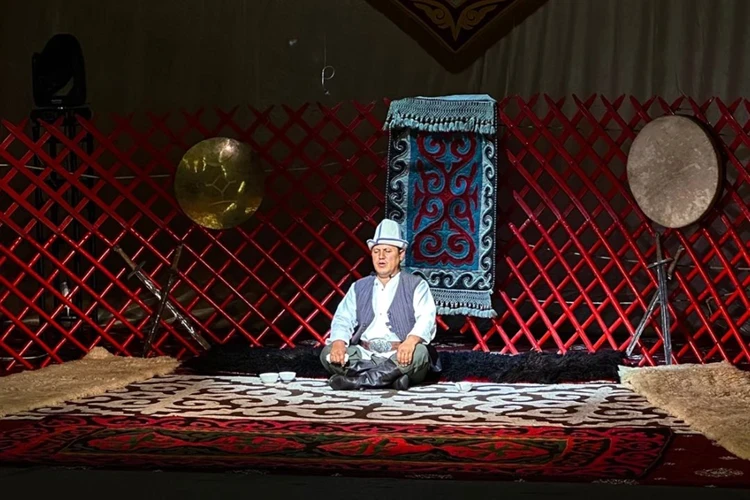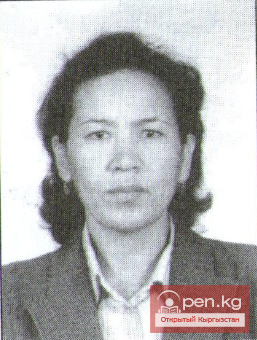Storytellers - Manaschy
The great epic owes its thousand-year existence and development to the storytellers - Manaschy.
Manaschy is a folk professional artist who possesses the poetic and musical mastery of orally conveying the content of the epic. The word “manaschy” is relatively new, arising in connection with the study of the great epic.
In the history of Kyrgyz nomadic culture, there has developed a special attitude towards storytelling creativity. The latter was considered an art of elite quality and was the domain of exclusively gifted individuals. In the popular consciousness, storytelling was perceived as a product of the highest spirituality, accessible only to the chosen ones of nature and higher divine powers.
One manifestation of the Kyrgyz people's serious attitude towards their epic is the famous tale of a prophetic dream, in which the future manaschy receives from God or from the hero Manas a sacred blessing for professional storytelling.
The most important factors for the widespread development of epic culture were the people's need for artistically crafted information about the events of historical past and the aesthetic enjoyment experienced by listeners in an atmosphere of meaningful leisure.
The authority of storytellers among the people was extremely high, as they were not only great artists but also outstanding personalities who closely touched the people's sacred heritage - "Manas." Manaschy combines the qualities of a philosopher, historian, artist, poet, and musician.
By adopting the tradition of storytelling from a teacher-mentor or by inheritance, manaschy, in turn, complements and refines its ideological and artistic content. The storyteller conveys the content of the epic in the form of poetic-musical improvisation, keeping in mind thousands of lines of poetry and hundreds of melodies. The auditory performance is reinforced by the plasticity of body and hand movements, as well as facial expressions. The sole actor of the epic "theater" is also its director: manaschy holds the listeners in his power for many hours and even days thanks to the hypnotic power of the intoned word and precisely calculated dramaturgy of the narrative.
Beginning to narrate an episode relatively restrained, manaschy gradually intensifies the emotional tension of the narrative. This property of a lively, passionate transmission of the epic distinguishes “Manas” from the epic cultures of other peoples.
The fruits of many years of apprenticeship, self-improvement, and inspiration are presented to numerous listeners. The audience did not allow the canons of the traditions of this ancient art to be violated but welcomed original techniques, virtuoso mastery of the performance apparatus, and moments of creative inspiration that arose only in contact with the audience, who empathized with their idol in the intense act of creation.
Despite the great importance of traditions in this form of folk art, each prominent manaschy brought their individuality into it, which is inherent, as is known, in the nature of improvisation. The personal element touches all components - content, tempo-rhythm, timbre of voice, plasticity, and expression.
According to established traditions, storytellers are divided into three groups, depending on which part of the trilogy of the great epic they specialize in: manaschy - performers of the first part of the trilogy, namely "Manas"; semeteichi - performers of the second part - "Semetei"; seiteikchi - performers of the third part - "Seitek." This "distribution" is quite conditional: there have been cases when the same storytellers combined performances of different parts of the trilogy. As storytelling practice shows, such universalism is characteristic of masters of epic word and music who possess the highest degree of talent. One of such legendary authors is mentioned in the very epic "Manas":
“The son of Yraman, the singer, is Ychkyr, with forty knots in his pants.”
(Translation by R. Kydyrbaeva)
According to folklore, the great epic owes its birth to Yrchyp-singer - the son of Yraman. The "Koshok," composed by him on the death of Manas, turned out to be so adequate to the very personality of the hero that it became a powerful impetus for the creation of the epic. The name of the companion of the legendary leader - storyteller Jaysan is also mentioned in "Manas."
One of the manaschy, whose name has been preserved in the memory of the Kyrgyz people, was Toktogul, who lived about 500 years ago. The scientific literature mentions a manaschy named Nouruz (18th century).
The names of the celebrated storytellers of the 19th century have reached us. They lived and created in the "truly epic period," when the epic dominated in Kyrgyzstan, and among the Kyrgyz "the epic blossomed in the full sense of the word" (V. Bartold): Keldibek Baryboz uulu, Balik (Bekmurat) Kumar uulu, his son Naimanbay, Tynibek Japy uulu, Chonbash (Narmantai), Chokje Omur uulu, and others.
Scholars divide storytellers into two groups. The first group includes storytellers who meet three criteria: professional activity, creation of their own version of the epic, and original performance style. They are commonly referred to as innovative storytellers. Those manaschy who do not meet all these requirements or meet them partially belong to the second group of storytellers. They are called popularizers of the epic.
On the other hand, in the folk environment, epic storytellers are divided into four groups according to the degree of talent. The first group is "chon manaschy," or "zalkar manaschy" (traditionally "chon jomokchu" or "zal-kar jomokchu"), which means "big" or "great" manaschy. This group includes the aforementioned manaschy of the 19th century, and from the storytellers of the 20th century - Sagymbay Orozbakov, Sayakbay Karalaev, and Shaabay Azizov.
The title of "great" manaschy is usually awarded to individuals possessing immense talent for poetic improvisation. They know and remember the epic in its entirety, have their own version and performance style, and can develop the content of the tale thanks to their own creative and philosophical ideas.
The second group, defining the degree of the storyteller's talent, is "chynygy manaschy" ("genuine or true manaschy"). This group includes Moldobasan Musulmankulov, Bagysh Sazanov, Togolok Moldo (Bayymbet Abdrahmanov), Mambetaly Ashymbaev, Shapak Yrysmen-diev, Mambet Chokmorov, and others, who lived and created mainly in the first half of the 20th century and left their own versions of the epic.
The storytellers of this group made the performance of "Manas" their profession, they know the main events of the epic well and convey them in their own musical-poetic style. However, they do not complement the epic and do not narrate it in full.
The third group is "chala manaschy" ("manaschy-craftsman"). This group includes manaschy who mainly perform well-known episodes of the epic that they have memorized and are unable to create their own versions. Among them are many storytellers whose creativity falls mainly in the post-October period: Toro Mamytov, Lapaz Kokkuzov, Kaba Atabekov, Sarynjy Kozhoberdiyev, Kalbyubyu Suyumbaeva, Mamyt Aldayirov, Akyn Shadykanov, Nasyr Iskenderov, Zholbors Turdaliev, Urkash Mambetaliev, Nazarkul Seydirakmanov, Ergash Tashymbetov, Sulayman (Akyn) Naziev, Duyshenaly Janayev, Oruzbay Urmambetov, Dautali Kasymbaev, Abdykerim Bekiyev, Seydene Moldoke kyzy, and others.
There is also a fourth group in Kyrgyz epic storytelling, which is mainly associated with the creativity of children and youth - "uyronchuk manaschy" ("beginner manaschy") or "bala manaschy" ("child-manashy").
This title can be awarded to young manaschy who are passionate about performing the epic and are influenced by some well-known storyteller. The manasologist S. Musaev wrote on this matter: "In reality, no manaschy becomes a storyteller of the epic 'Manas' without having listened to the events of the epic from other manaschy or from one of them and without undergoing at least a brief training with them."
In our time, the training of beginner manaschy is acquiring new forms. With the help of teachers and parents, children memorize the text of the epic "Manas," master its melody through radio, television, concerts, and audio recordings and try their skills in listening audiences and artistic competitions.
The 20th century, especially its first half, can be called the classical age in the history of Kyrgyz national epic culture without exaggeration. It is during this period that the peak of storytelling creativity occurs, when the improvisational talents of such professional manaschy as Sagymbay Orozbakov, Sayakbay Karalaev, Moldobasan Musulmankulov, Aktan Tynibekov, Shaabay Azizov, Mambet Chokmorov, and others were fully revealed.
Choyuke Omur uulu (1863—1925) - manaschy, mentor of Sayakbay Karalaev. Born in the city of Karakol (now Issyk-Kul region). In turn, he learned all the secrets of storytelling art from manaschy Akylbek and Tynibek. In 1900, he moved to Talas. Choyuke narrated all parts of the trilogy of the great epic in full, but unfortunately, his version was not recorded. Folk rumor suggests that the episodes "At chabysh," "The Tale of Bakai" in his performance moved people to tears.
Kenzhekara Kalcha uulu (1859—1929) - a prominent semeteichi and yrych of his time. Known as a bright storyteller of the second part of the epic - "Semetei," accompanying himself on the kyl kyake. In 1903, episodes "The Marriage of Semetei to Aichurek," "The Song of Akbale" were recorded from him on a phonograph. The Russian scholar B. Smirnov recorded some fragments of Kenzhekara's performance in his book "In the Steppes of Turkestan" and sketched the storyteller.
Nazarkul Seydirakmanov (born 1951) - solo manaschy of the Toktogul Kyrgyz State Philharmonic. Born in the village of Danbagar, Talas district, Talas region. Winner of the first prize at the international manaschy competition in honor of the 1000th anniversary of the epic "Manas" (1995).
Like other storytellers, Nazarkul explains his calling with a prophetic dream. He began narrating the epic from childhood and considers himself a student of Sayakbay Karalaev. The version of "Manas" belonging to Seydirakmanov includes all parts of the trilogy and is close in style to the Issyk-Kul storytelling school. The process of recording Seydirakmanov's version of the great epic continues.
Outstanding Manaschy:
Sagymbay Orozbakov (1867—1930)
Sayakbay Karalaev (1894—1972)
Togolok Moldo (real name - Bayymbet Abdrahmanov, 1860—1942)
Moldobasan Musulmankulov (1883—1961)
Mambet Chokmorov (1896—1973)
Jusup Mamay (born 1918)
Seydene Moldoke kyzy (born 1922)
Kaba Atabekov (born 1926)
Shaabay Azizov (born 1927)
Urkash Mambetaliev (born 1934)
















































